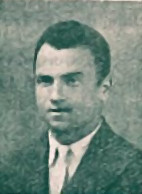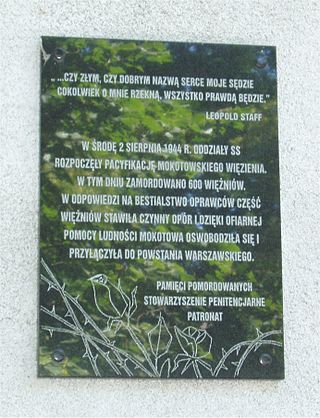
Zambrów(listen) is a town in northeastern Poland with 21,166 inhabitants (2020). It is the capital of Zambrów County. Situated in the Podlaskie Voivodeship, previously in Łomża Voivodeship (1975–1998).

The 2nd Panzer Division was an armoured division in the German Army, the Heer, during World War II.
The Panzer Division "Kempf", also East Prussia Panzer Formation was an ad hoc combined arms formation consisting of regular German Army personnel and SS. It was created for operations out of East Prussia during the Invasion of Poland in 1939. The formation was generally called Panzer Division "Kempf" after General der Panzertruppe Werner Kempf assumed command, though it was only about half the strength of the other Panzer Divisions of the time.

The 3rd Light Division was raised in November 1938. In 1939 it fought in the Invasion of Poland. On 4 September 1939, soldiers from the division entered the region of Katowice where they met resistance from the local Polish population. In retribution 80 Polish prisoners of war were gathered in Kosciuszko Square by German soldiers and executed.
The 2nd Light Division was a motorized division created in 1938 during the German rearmament. It participated in the invasion of Poland. After the end of the Polish campaign the division was converted into a panzer division, forming the 7th Panzer Division.

The 4th Panzer Division was an armored division in the Army of Nazi Germany.

Fritz Witt was a German SS commander during the Nazi era. During World War II, he served with the SS Division Leibstandarte before taking command of the SS Division Hitlerjugend. He was killed in action in June 1944.

Szymon Datner was a Polish historian, Holocaust survivor and underground operative from Białystok, best known for his studies of the Nazi war crimes and events of The Holocaust in the Białystok region. His 1946 Walka i zagłada białostockiego ghetta was one of the first studies of the Białystok Ghetto.

Wieruszów County is a unit of territorial administration and local government (powiat) in Łódź Voivodeship, central Poland. It came into being on January 1, 1999, as a result of the Polish local government reforms passed in 1998. Its administrative seat and only town is Wieruszów, which lies 106 kilometres (66 mi) south-west of the regional capital Łódź.

The Ciepielów massacre that took place on 8 September 1939 was one of the largest and best documented war crimes of the Wehrmacht during its invasion of Poland. On that day, the forest near Ciepielów was the site of a mass murder of Polish prisoners of war from the Polish Upper Silesian 74th Infantry Regiment. The massacre was carried out by soldiers from the German Army's 15th Motorized Infantry Regiment, 29th Motorized Infantry Division, under the command of Colonel Walter Wessel.
The 18th Infantry Division was a division of the Polish Armed Forces. The division was originally part of Polish Army during the interbellum period, which took part in the Polish September Campaign. Stationed in Łomża and commanded in 1939 by Colonel Stefan Kossecki, it was part of the Narew Independent Operational Group.

The Ochota Massacre was a wave of German-orchestrated mass murder, looting, arson, torture and rape, which swept through the Warsaw district of Ochota from 4–25 August 1944, during the Warsaw Uprising. The principal perpetrators of these war crimes were the Nazi collaborationist S.S. Sturmbrigade R.O.N.A., the so-called "Russian National Liberation Army", commanded by Bronislav Kaminski.

The mass murder on Dzika street was a war crime committed by German troops against Polish civilians during World War II, amidst the Warsaw Uprising on August 21, 1944. The execution took place in the yard of a housing block on Dzika 17 street. Around 200 civilians were killed. While nowhere near as large as the wholesale massacre in Wola, it was one of the largest mass murder carried out by the Nazis during the battle of Warsaw Old Town.

The execution at Powązkowska Street - a mass murder of 22 Warsaw residents of Powązki by the Germans on 1 August 1944. This execution, which claimed the lives of men living in a house at 41 Powązkowska Street, was one of the first German crimes committed during the suppression of the Warsaw Uprising.

Stauferkaserne prison - a provisional prison, and at the same time a gathering point for expelled Warsaw residents, established by the Germans during the first days of the Warsaw Uprising on the grounds of the SS-Stauferkaserne barracks at 4 Rakowiecka Street. In August and September 1944 over a thousand residents of the district passed through the SS barracks in Mokotów. They were detained there in harsh conditions and were subjected to extremely brutal treatment. During the Warsaw Uprising, the Stauferkaserne area was the scene of numerous executions, the victims of which were at least 100 people.

Suppression of Mokotów - a wave of mass murders, looting, arson and rapes that swept through the Warsaw district of Mokotów during the Warsaw Uprising in 1944. Crimes against prisoners of war and civilians of the district were committed by the Germans until the capitulation of Mokotów on September 27, 1944, although they intensified in the first days of the uprising.

The Massacre in the Mokotów prison - mass murder of residents of the Mokotów prison in Warsaw by the Germans on the second day of the Warsaw Uprising. On August 2, 1944, soldiers of the Waffen-SS - SS-Pz. Gren. Ausb.-und Ers. Btl. 3 shot about 600 Poles on the premises of the prison at 37 Rakowiecka Street. It was one of the biggest crimes committed by the Germans in Mokotów during the suppression of the Warsaw Uprising. During the massacre, some prisoners actively resisted the Nazis, which allowed several hundred people to escape to the area controlled by the insurgents.

The Zambrów massacre was a war crime that took place on the night of 13–14 September 1939. It was one of the major war crimes of the Wehrmacht during the invasion of Poland. During that night, the makeshift prisoner-of-war camp in Zambrów was disturbed by a number of panicked horses, and more than 200 Polish soldiers, trying to move out of their way, were gunned down by German sentries. Some witnesses later said the horses had been purposely released into the camp by the German sentries, who used the incident as a pretext to massacre the prisoners.

The Katowice massacre or the Bloody Monday in Katowice that took place on 4 September 1939 was one of the largest war crimes of the Wehrmacht during its invasion of Poland. On that day German Wehrmacht soldiers aided by the Freikorps militia executed about 80 of the Polish defenders of the city. Those defenders were self-defense militia volunteers, including former Silesian Insurgents, Polish Boy and Girl Scouts, and possibly a number of Polish soldier stragglers from retreating Polish regular forces who joined the militia.

The Defense of Katowice was carried out by small groups of irregular Polish militia on 3–4 September 1939 during the German invasion of Poland. German troops secured the city by the end of 4 September.
















